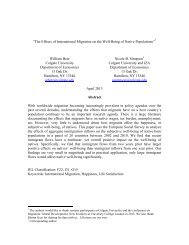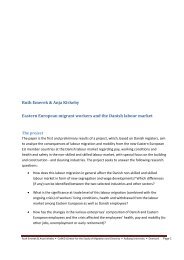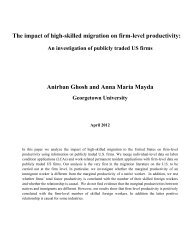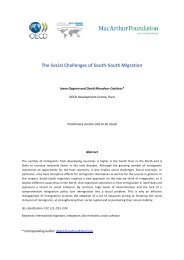The Role of Source- and Host-Country Characteristics in ... - CReAM
The Role of Source- and Host-Country Characteristics in ... - CReAM
The Role of Source- and Host-Country Characteristics in ... - CReAM
You also want an ePaper? Increase the reach of your titles
YUMPU automatically turns print PDFs into web optimized ePapers that Google loves.
supply <strong>and</strong> household production has to be assumed. 11<br />
Independent on which k<strong>in</strong>d <strong>of</strong><br />
model is assumed to underlie a couple’s decision-mak<strong>in</strong>g process, women are predicted<br />
to be less likely to participate the higher the partner’s earn<strong>in</strong>gs potential. Second, there<br />
is evidence <strong>of</strong> assortative mat<strong>in</strong>g <strong>in</strong> the marriage market, i.e., more educated (<strong>and</strong> hence<br />
higher <strong>in</strong>come) men tend to be married to more educated women (see, e.g., Pencavel, 1998).<br />
<strong>The</strong> husb<strong>and</strong>’s higher <strong>in</strong>come will decrease the <strong>in</strong>centives for his wife to engage <strong>in</strong> market<br />
work <strong>and</strong>, <strong>in</strong> this way, mask the strength <strong>of</strong> the effect <strong>of</strong> source-country culture on women’s<br />
labor supply decisions. We attempt to capture the impact <strong>of</strong> both assortative mat<strong>in</strong>g <strong>and</strong><br />
jo<strong>in</strong>t decision mak<strong>in</strong>g with<strong>in</strong> the household by controll<strong>in</strong>g for the partner’s highest level <strong>of</strong><br />
education <strong>and</strong> his work<strong>in</strong>g hours. However, as these variables are endogenous to a women’s<br />
labor force participation decision, we will not <strong>in</strong>clude them <strong>in</strong> our basic regression model.<br />
While the aforementioned variables capture the human capital <strong>of</strong> a woman’s partner,<br />
the partner’s cultural background is also likely to play a role <strong>in</strong> her labor force participation<br />
decision. Fernández <strong>and</strong> Fogli (2009) show that a husb<strong>and</strong>’s culture, as measured by the<br />
LFPR <strong>in</strong> his father’s country <strong>of</strong> birth, is an important determ<strong>in</strong>ant <strong>of</strong> his wife’s employment<br />
decision. More generally, Fernández et al. (2004) as well as Johnston et al. (2012) f<strong>in</strong>d<br />
evidence that an important factor expla<strong>in</strong><strong>in</strong>g whether a man’s wife works is whether his<br />
own mother worked when he was grow<strong>in</strong>g up. <strong>The</strong> authors argue that a mother’s decision<br />
to work or not is <strong>in</strong>fluenced by her beliefs about women’s roles, which then have been<br />
transmitted to her son <strong>and</strong> <strong>in</strong>fluenced any household decision affect<strong>in</strong>g his wife’s work<br />
outcome. Unfortunately, the ESS data do neither conta<strong>in</strong> <strong>in</strong>formation on a partner’s<br />
cultural background (i.e., his immigration status <strong>and</strong> his country <strong>of</strong> orig<strong>in</strong>), nor do they<br />
<strong>in</strong>clude <strong>in</strong>formation on his parent’s employment outcomes, mak<strong>in</strong>g it impossible to control<br />
for any k<strong>in</strong>d <strong>of</strong> assortative mat<strong>in</strong>g with respect to perceptions about gender roles. In<br />
particular, a woman who would like to work is presumably more likely to marry a man<br />
who would be <strong>in</strong> agreement with these choices. Given that the FLFPR <strong>in</strong> the source<br />
country serves as proxy for an <strong>in</strong>dividual’s beliefs regard<strong>in</strong>g women’s role <strong>in</strong> society, we<br />
would assume that women from high FLFPR countries will be more likely to marry men<br />
from high FLFPR countries. Hence, we have to keep <strong>in</strong> m<strong>in</strong>d that part <strong>of</strong> the effect <strong>of</strong> our<br />
cultural proxy might not capture a direct impact on an immigrant women’s decision to<br />
participate <strong>in</strong> the labor market. Rather, it might reflect an <strong>in</strong>direct effect <strong>of</strong> a woman’s<br />
mat<strong>in</strong>g decision, which is <strong>in</strong>fluenced by her beliefs regard<strong>in</strong>g gender roles <strong>and</strong> ultimately<br />
effects her decision about market work.<br />
As Blau <strong>and</strong> Kahn (2011) show, a strong predictor <strong>of</strong> an immigrant women’s labor<br />
supply <strong>in</strong> the host country is their own labor supply <strong>in</strong> the source country prior to migrat<strong>in</strong>g.<br />
If immigrant women from high FLFP countries have more work experience prior to their<br />
11 <strong>The</strong> economic theory <strong>of</strong> jo<strong>in</strong>t labor supply decisions with<strong>in</strong> the household was <strong>in</strong>itiated by Becker<br />
(1965) <strong>and</strong> developed, <strong>in</strong>t. al., by Gronau (1977), Manser <strong>and</strong> Brown (1980) <strong>and</strong> McElroy <strong>and</strong> Horney<br />
(1981).<br />
10







